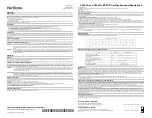
I/O Terminal /
MANUAL CONFIGURATION
37
Synchronous Mode
As explained in the table above, there are three different synchronous modes:
Standard Synchronous Mode
In standard synchronous mode the Standard-Bus cycle is always started immediately
following reception of the Data_Exchange telegram from the DP master. The outputs are
therefore generated as quickly as possible, while the input cycles are always one DP cycle
old:
It is important here to ensure that the duration of the Standard-Bus cycle plus approx. 20%
(to allow for the lower priority processes on the coupler) is shorter than the DP cycle time.
Synchronous Mode With Optimized Input Update (one cycle)
In optimized input update, the start of the Standard-Bus cycle can be delayed following
reception of the Data_Exchange telegram, so that the inputs are more up-to-date than they
are in standard synchronous mode, whereas generation of the outputs is more severely
delayed. It is important here to ensure that the duration of the Standard-Bus cycle, plus the
delay time, plus approx. 20% (to allow for the lower priority processes on the coupler) is
shorter than the DP cycle time.
















































